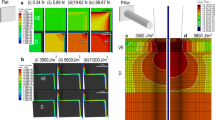Abstract
Objective and design
AIRmax and AIRmin mice differ in their local acute inflammatory reactions to polyacrylamide beads (Biogel). These lines were developed to identify genes that affect the intensity of the acute inflammatory response (AIR) and to investigate the cellular and molecular mechanisms of acute inflammation. Although these lines are well established, differences in their responses to chronic inflammatory Biogel exposure have not yet been described. We investigated whether the selective process that modified the acute inflammatory responses in these animals also affected the development of their chronic inflammatory responses.
Results
Inflammatory exudate cell infiltration was more intense in AIRmax than AIRmin mice at both 48 h and 30 days. Genes involved in signal transduction and immune/inflammatory responses were differentially expressed in the treated skin of AIRmax and AIRmin mice, and divergent expression of some acute inflammatory response genes was detected up to 30 days post-Biogel. However, distinct expression of several pro and anti-inflammatory response genes in both periods was observed.
Conclusion
These results indicate that the selective process for acute inflammation affected the development of chronic inflammatory responses to Biogel, suggesting common genetic control.







Similar content being viewed by others
Abbreviations
- AIR:
-
Acute Inflammatory Response
- CCL2:
-
Chemokine (C–C motif) ligand 2
- CXCL1:
-
Chemokine (C–X–C motif) ligand 1
- CXCL2:
-
Chemokine (C–X–C motif) ligand 2
- CXCR2:
-
Chemokine (C–X–C motif) receptor 2
- DAMP:
-
Danger-associated molecular pattern
- EASE:
-
Expression Analysis Systematic Explorer
- FDR:
-
False Discovery Rate
- IL-1β:
-
Interleukin-1 beta
- IL-6:
-
Interleukin-6
- PAMP:
-
Pathogen-associated molecular pattern
- PCR:
-
Polymerase chain reaction
- PRR:
-
Pattern recognition receptor
- QTL:
-
Quantitative Trait Loci
- SAM:
-
Significance Analysis of Microarray
- SNP:
-
Single Nucleotide Polymorphism
- TGF-β:
-
Transforming growth factor, beta 1
- TNF-α:
-
Tumor necrosis factor alpha
References
Medzhitov R. Origin and physiological roles of inflammation. Nature. 2008;13:428–35.
Perreti M. Endogenous mediators that inhibit the leukocyte–endothelium interaction. Trends Pharmacol Sci. 1997;18:418–25.
Stiffel C, Ibañez OM, Ribeiro OG, Decreusenfond C, Mouton D, Siqueira M, Biozzi G. Genetics of acute inflammation: inflammatory reaction in inbred lines of mice and their interline crosses. Exp Clin Immunogenet. 1990;7:221–33.
Ibañez OM, Stiffel C, Ribeiro OG, Cabrera WH, Massa S, De Franco M, Sant`ana OA, Decreusenfond C, Mouton D, Siqueira M, Biozzi G. Genetics of nonspecific immunity: I. Bidirectional selective breeding of lines of mice endowed with maximal or minimal inflammatory responsiveness. Eur J Immunol. 1992;22:2555–63.
Biozzi G, Ribeiro OG, Saran A, Araújo ML, Maria DA, De Franco M, Cabrera WH, Sant`anna OA, Massa S, Covelli V, Mouton D, Neveu T, Siqueira M, Ibañez OM. Effect of genetic modification of acute inflammatory responsiveness on tumorigenesis in the mouse. Carcinogenesis. 1998;18:337–46.
Araújo LM, Ribeiro OG, Siqueira M, De Franco M, Starobinas N, Massa S, Cabrera WH, Mouton D, Seman M, Ibañez OM. Innate resistance to infection by intracellular bacterial pathogens differs in mice selected for maximal or minimal acute inflammatory response. Eur J Immunol. 1998;28:2913–20.
Vigar ND, Cabrera WH, Araújo LM, Ribeiro OG, Ogata TR, Siqueira M, Ibañez OM, De Franco M. Pristane-induced arthritis in mice selected for maximal or minimal acute inflammatory reaction. Eur J Immunol. 2000;30:431–7.
Vorraro F, Galvan A, Cabrera WHK, Carneiro PS, Ribeiro OG, De Franco M, Starobinas N, Jensen JR, Seman M, Dragani TA, Ibañez OCM. Genetic control of IL-1b production and inflammatory response by the mouse Irm1 locus. J Immunol. 2010;2010(185):1616–21.
Galvan A, Vorraro F, Cabrera W, Ribeiro OG, Starobinas N, Jensen JR, Carneiro PS, De Franco M, Gao X, Ibañez OCM, Dragani TA. Association study by genetic clustering detects multiple inflammatory response loci in non-inbred mice. Genes Immun. 2011;12:390–4.
Giulietti A, Overbergh L, Valckx D, Decallonne B, Bouillon R, Mathieu C. An overview of real-time quantitative PCR: applications to quantify cytokine gene expression. Methods. 2001;25:386–440.
Livak KJ, Schmittgen TD. Analysis of relative gene expression data using real-time quantitative PCR and the 2−ΔΔCt method. Methods. 2001;25:402–8.
Kobayashi Y. Neutrophil infiltration and chemokines. Crit Rev Immunol. 2006;26:307–16.
Ribeiro OG, Maria DA, Adriouch S, Pechberty S, Cabrera WHK, Morriset J, Ibañez OM, Seman M. Convergent alteration of granulopoiesis, chemotactic activity, and neutrophil apoptosis during mouse selection for high acute inflammatory response. J Leukoc Biol. 2003;74:497–506.
Carneiro OS, Peters LC, Vorraro F, Borrego A, Ribeiro OG, Starobinas N, Jensen JR, Cabrera WHK, Ibañez OM, De Franco M. Gene expression profiles of bone marrow cells from mice phenotype-selected for maximal or minimal acute inflammations: searching for genes in acute inflammation modifier loci. Immunology. 2009;2009(128):562–71.
De Franco M, Peters LC, Correa MA, Galvan A, Canhamero T, Borrego A, Jensen JR, Gonçalves J, Cabrera WH, Starobinas N, Ribeiro OG, Dragani TA, Ibañez OM. Pristane-induced arthritis loci interact with the Slc11a1 gene to determine susceptibility in mice selected for high inflammation. PLoS One. 2014;9(2):e88302.
Leemans JC, Cassel SL, Sutterwala FS. Sensing damage by the NLRP3 inflammasome. Immunol Rev. 2011;243:152–62.
Prince LR, Whyte MK, Sabroe I, Parker LC. The role of TLRs in neutrophil activation. Cur Opin Pharmacol. 2011;11:397–403.
Chen GY, Nuñez G. Sterile inflammation: sensing and reacting to damage. Nat Rev Immunol. 2010;10:827–37.
Acknowledgments
This work was supported by FAPESP and CNPq. MDF and OMI have fellowship from CNPq.
Author information
Authors and Affiliations
Corresponding author
Ethics declarations
Conflict of interest
No competing interests.
Additional information
Responsible Editor: John Di Battista.
Rights and permissions
About this article
Cite this article
Fernandes, J.G., Canhamero, T., Borrego, A. et al. Distinct gene expression profiles provoked by polyacrylamide beads (Biogel) during chronic and acute inflammation in mice selected for maximal and minimal inflammatory responses. Inflamm. Res. 65, 313–323 (2016). https://doi.org/10.1007/s00011-016-0918-1
Received:
Revised:
Accepted:
Published:
Issue Date:
DOI: https://doi.org/10.1007/s00011-016-0918-1




